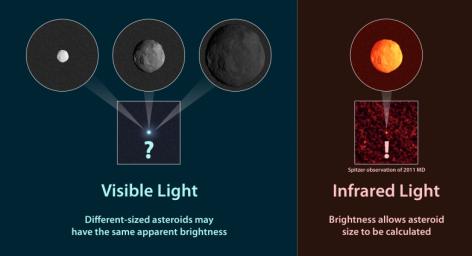How to Measure the Size of an Asteroid
Caption:
Observations of infrared light coming from asteroids provide a better estimate of their true sizes than visible-light measurements. This diagram illustrates why. At left, are three asteroids with different sizes and compositions. Even though they are different, they can appear to the same to a visible-light telescope because they reflect the same amount of sunlight. It's impossible to know their sizes.
For example, the small, white asteroid has a more reflective surface so it can appear to have the same brightness as a larger, dark asteroid. The same is true of a shiny penny and larger piece of dull copper -- they could, in some circumstances, reflect the same amount of total light.
The right side of the illustration shows what happens in the infrared. When an asteroid is hit with sunlight, it radiates some of that back as infrared light. The amount of infrared light that comes off an asteroid thus depends on the size of its exposed surface area.
When infrared and visible-light observations are combined, the reflectivity of a surface, or its albedo, can also be determined.
Background Info:
NASA's Jet Propulsion Laboratory, Pasadena, Calif., manages the Spitzer Space Telescope mission for NASA's Science Mission Directorate, Washington. Science operations are conducted at the Spitzer Science Center at the California Institute of Technology in Pasadena. Spacecraft operations are based at Lockheed Martin Space Systems Company, Littleton, Colorado. Data are archived at the Infrared Science Archive housed at the Infrared Processing and Analysis Center at Caltech. Caltech manages JPL for NASA.
For more information about Spitzer, visit
http://spitzer.caltech.edu
and
http://www.nasa.gov/spitzer
.
Cataloging Keywords:
| Name |
Value |
Additional Values |
| Target |
|
|
| System |
|
|
| Target Type |
Asteroid |
|
| Mission |
Spitzer Space Telescope |
|
| Instrument Host |
Spitzer Space Telescope |
|
| Host Type |
Space Telescope |
|
| Instrument |
|
|
| Detector |
|
|
| Extra Keywords |
Color, Infrared |
| Acquisition Date |
|
| Release Date |
2014-06-19 |
| Date in Caption |
|
|
| Image Credit |
NASA/JPL-Caltech |
| Source |
photojournal.jpl.nasa.gov/catalog/PIA18454 |
| Identifier |
PIA18454 |

 Planetary Data System
Planetary Data System
